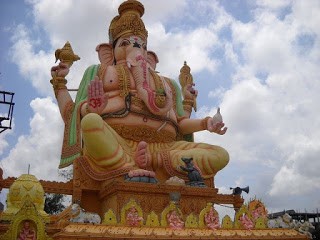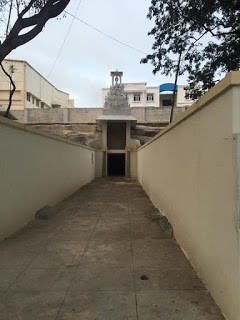Indian Temples
January 11, 2016

Diana Stanley is a Museum employee who is studying abroad in India. She will be updating the blog as a Field Reporter while she travels and explores.
Temples are a key aspect of Indian culture and they are everywhere! Just about every street has a small complex, shrine, altar, or miscellaneous monument. Some are well kept while others fade into the background with peeling paint and dusty open walls. In my short time in Bengaluru, I have had the privilege of seeing many temples, but there are three which truly stand out.
|
|
|
Logo for the International Society |
Sadly this article will not have any pictures from inside a temple as that is a punishable offense, and I did not feel like making my fellow intern bail me out of an Indian jail. Plus, I am all for respecting the wishes of other cultures when it comes to sacred spaces.
My entry into Hindu worship began with one of the biggest sanctuaries in the region--the ISKCON Temple. The acronym stands for the International Society for Krishna Consciousness or the Hare Krishna cult. Krishna is the most popular deity in modern Hinduism. The complex is a huge, modern construction of white rock and glass. Built on wasteland in the mid-1990s, it cost 37 crores to build (or more than $5 million). Unlike most temples, its outside lacks color which calls to mind Greek and Roman architecture tones. As it is the regional center for the Krishna cult, thousands of visitors come every day, meaning long lines. As they wait their turn to see the deity, travelers pray, meditate, and chant sacred verses. Before entry, they are blessed and then proceed to view the figure of Krishna, who is seated in a niche in a 50 foot wall of gold. Travelers are blessed again in front of the figure and then leave.
|
|
The ISKCON Temple struck me because despite its strict picture policy, it is highly commercialized. One can pay for a fast track through the line and a closer distance to Krishna or purchase the religious sweet cakes one is expected to eat after visiting. There are two spaces for souvenir shopping--one right after the figure! On the other hand, the temple uses that money to do a lot of good. ISKCON provides all of the rice for the government schools in Bengaluru, which feeds over a million poor children a year. Additionally, every visitor may take a rice dish for free after visiting the temple which turns it into a soup kitchen style charity for the surrounding poor.
|
|
|
Photo of "cave temple" by Diana Stanley. |
My visit the following week to a Ganesha temple was the complete opposite experience. Ganesha is another extremely popular Hindu deity. This temple is a local neighborhood complex which was established about hundred years ago. Cheerful, painted, and bustling during the lunch hour, it boasts an entertaining foundation story. A local bull was eating all of the farmers’ groundnuts. Groundnut is an Indian word for peanut. In desperation to save their crops, they prayed to Ganesha and he told them to give a small portion of their groundnuts to him and in exchange the bull would never bother them again. Apparently, the god kept his promise because every year farmers bring in their harvest for a ginormous groundnut festival.
The Ganesha temple was more personable than ISKCON. My guide was an Aradhana teacher who lives in the area, and she knew the Hindu priest giving out blessings as well as some of the temple visitors. Having a local show me around is also probably why I didn’t get glared at like the other foreign visitor to the temple. While there was less gold and rougher pavement, the ground was decorated in chalk drawings. The chalk is renewed regularly to welcome the god into the temple and the hearts of his devotees. Since no shoes and socks are allowed inside, I spent lots of time admiring the drawings while trying not to cut my feet!
The ISKCON and Ganesha temples are very different from each other, but both are easily identified as temples from a distance. This is not so with the Hulimavu cave temple! Cave temples begin as natural caves or are carved into a hillside. Most cave temples are Buddhist, but there is a local Hindu temple about twenty minutes by car from the convent. Unassuming from the outside, the Hulimavu temple’s interior is smooth, polished rock which creates a 'V' shaped pocket of sanctuary space. Cave temples are intended as a meditation space for worshipers. It was built sometime during the 14th century, making Hulimavu fairly new, as far as cave temples go. A school is on top of the hill, but the temple was deserted in the late afternoon. On the weekends, people gather for preaching in a nearby building, as the temple was not built to accommodate these gatherings.
|
|
|
Ganesha Temple in Bengaluru. |
India’s temples come is a plethora of shapes and sizes. They are grand and tiny, opulent and simple, friendly and frigid. Bengaluru is but one city, and I found three completely different temple architecture styles within it. Each experience was unique in its own way. For my part, I can see the attraction of ISKCON, but I preferred the quiet cold of the cave.


